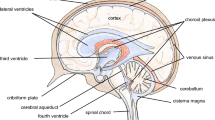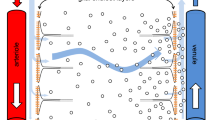Abstract
The possibility that red cell-sequestered amino acids such as phenylalanine are available for transport through the brain capillary wall, i.e., the blood-brain barrier (BBB), in vivo was investigated in the present studies with the carotid artery injection technique. Control studies included the examination of the availability of red cell-sequestered solutes such as phenylalanine ord-glucose to liver cells in vivo using a portal vein injection technique. The results show that red cell-sequestered phenylalanine is not available for transport through the BBB or into rat liver in vivo, but human red cell-sequesteredd-glucose is available for uptake by liver following portal injection. Therefore, given favorable kinetics it is possible for red cell-sequestered solute to be available for uptake by tissues. However, in the case of neutral amino acids such as phenylalanine, red cell-sequestered amino acid is not available for transport through the BBB in vivo.
Similar content being viewed by others
References
Winter, C.G., and Christensen, H.N. 1964. Migration of amino acids across the membrane of the human erythrocyte. J. Biol. Chem. 259:872–878.
Winter, C.G., and Christensen, H.N. 1965. Contrasts in neutral amino acid transport by rabbit erythrocytes and reticulocytes. J. Biol. Chem. 240:3594–3600.
Aoki, T.T., Brennan, M.F., Muller, W.A., Moore, F.D., and Cahill, Jr., G.F. 1972. Effect of inuslin on muscle glutamate uptake. Whole blood versus plasma glutamate analysis. J. Clin. Invest. 51:2889–2894.
Aoki, T.T., Brennan, M.F., Muller, W.A., Soeldner, J.S., Alpert, J.S., Saltz, S.B., Kaufmann, R.L., Tan, M.H., and Cahill, Jr., G.F. 1976. Amino acid levels across normal forearm muscle and splanchnic bed after a protein meal. Am. J. Clin. Nutr. 29:340–350.
Cahill, Jr., G.F., Aoki, T.T., and Smith, R.J. 1981. Amino acid cycles in man. Current Topics in Cellular Regeneration 18:389–400.
Hargreaves-Wall, K.M., Buciak, J.B., and Pardridge, W.M. 1990. Measurement of free-intracellular and transfer RNA amino acid specific activity and protein synthesis in rat brain in vivo. J. Cereb. Blood Flow Metabol. 10:162–169.
Oldendorf, W.H. 1970. Measurement of brain uptake of radiolabeled substances using tritiated water internal standard. Brain Res. 24:372–376.
Pardridge, W.M., and Jefferson, L.S. 1975. Liver uptake of amino acids and carbohydrates during a single circulatory passage. Am. J. Physiol. 228:1155–1161.
Baldwin, S.A., and Lienhard, G.E. 1989. Purification and reconstitution of glucose transporter from human erythrocytes. Meth. Enzymol. 174:39–50.
Jacquez, J.A. 1984. Red blood cell as glucose carrier: significance for placental and cerebral glucose transfer. Am. J. Physiol. 246:R289-R298.
Oldendorf, W.H. 1971. Brain uptake of radiolabeled amino acids, amines, and hexoses after arterial injection. Am. J. Physiol. 221:1629–1639.
Crandall, R.L., and Pardridge, W.M. 1989. Triiodothyronine bound to red blood cells is not available for transport through the blood-brain barrier. Neurochem. Res. 14:657–659.
Pardridge, W.M. and Fierer, G. 1985. Blood-brain barrier transport of butanol and water relative to N-isopropyl-p-[125I]iodoamphetamine (IMP) as an internal reference. J. Cereb. Blood Flow Metabol. 5:275–281.
Cefalu, W.T., Pardridge, W.M., and Premachandra, B.N. 1985. Hepatic bioavailability of thyroxine and testosterone in familial dysalbuminemic hyperthyroxinemia. J. Clin. Endocrinol. Metabol. 61:783–786.
Lupo, M.A., Cefalu, W.T., and Pardridge, W.M. 1990. Kinetics of lactate transport into rat liver in vivo. Metabolism 39:374–378.
Gray, S.J. and Sterling, K. 1950. The tagging of red cells and plasma proteins with radioactive chromium. J. Clin. Invest. 51:1604–1613.
Heitmann, R.N., and Bergman, E.N. 1981. Glutamate interconversions and glucogenicity in the sheep. Am. J. Physiol. 241:E465-E472.
Drewes, L.R., Conway, W.P., and Gilboe, D.D. 1977. Net amino acid transport between plasma and erythrocytes and perfused dog brain. Am. J. Physiol. 233:E320-E325.
Author information
Authors and Affiliations
Rights and permissions
About this article
Cite this article
Ellison, S., Pardridge, W.M. Red cell phenylalanine is not available for transport through the blood-brain barrier. Neurochem Res 15, 769–772 (1990). https://doi.org/10.1007/BF00968552
Accepted:
Issue Date:
DOI: https://doi.org/10.1007/BF00968552




